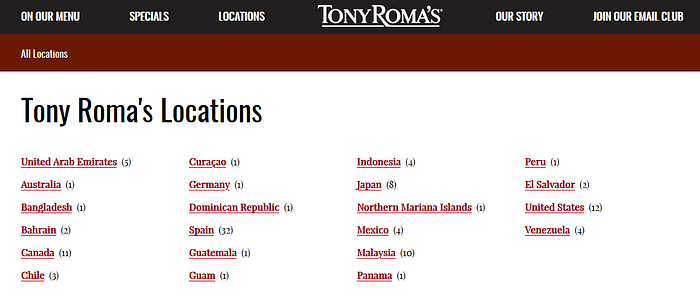The Rise and Fall of Tony Roma’s

Here is the video from this transcript: The Rise and Fall of Tony Roma’s
I recently came across some news that Tony Roma’s was continuing to expand internationally. But I do recall them having scaled down. There were more than 25 of their restaurants in Canada at some point. Now, its website displays 11 locations in total for Canada. Thus, I decided to look into what happened. Let’s dive in.

Tony Roma’s eponymous company opened in 1972 in Miami, Florida. At first, it was a regular steak and hamburger restaurant. But then, one day, the Chef decided to add in baby back ribs served with a rib sauce developed by Tony Roma. This proved to be the restaurant’s shining moment. Tony Roma’s became a symbol of barbecue rib dinners in the U.S. and was growing at a fast pace through word of mouth. To attract a diverse set of customers, it expanded its menu to include items such as seafood, pasta, chicken, and sandwiches.

Something very interesting happened in 1976. Clint Murchison Jr., the then owner of Dallas Cowboys, went for dinner at Tony Roma’s when the team was in town for Super Bowl. He was so impressed by the ribs that he outright bought Tony Roma’s U.S. franchise rights. Murchison and Roma formed a corporation, Roma Corp, to operate the restaurants and sell franchises across the US. But the duo was also peeking at the international scene. Three years later, they opened their first restaurant outside of the U.S. in Tokyo, Japan. Nowadays, there are 8 Tony Roma’s that are active in Japan.

The ribs were still a hit in the 80s, with Tony Roma’s opening more than 40 restaurants by 1985. They had stores in New York, Chicago, Oklahoma and California by then. They wanted to take the franchise to the next level and even hired a professional franchisee agency. But they decided to manage their franchises internally in the end. Their growth plan called for more multi-unit franchisees instead of company-owned ones. This strategy would give latitude to franchisees to open in multiple locations. For example, their Japanese franchisee operated stores in Japan, Hawaii and Guam.
In the mid 80s, the ownership of Roma was passed on the Murchison’s children and they appointed Kenneth Reimer, who was managing some companies owned by Murchison, as CEO. Apparently, when Reimer took over, the chain was not performing too well financially. He decided to relocate the headquarters to Dallas, which took a lot of time and effort to organize. I guess that Tony Roma was not happy about that decision and thus sold his interest to the Murchison family.
Although Clint Murchison Jr. was wealthy, he filed for bankruptcy in 1985. A year before, he even sold the Dallas Cowboys for 60 million dollars. Murchison had invested in a lot of businesses over the years. And when I say a lot, I mean he personally owned over 140 corporations. And the nail to the coffin was that he had put personal guarantees on them to finance the projects. When most of these businesses failed, he was personally liable to the creditors. Murchison had a terrible ending. He suffered from nerve disorder, which strapped him in a wheelchair unable to speak. He died from pneumonia in 1987.
Despite all this turmoil, Tony Roma’s had expanded to over 140 restaurants in 16 states and four continents by 1991. The growth was accompanied by remodeling the restaurants and introducing new operating systems. The menu also kept expanding to include fish and salads. At that point in time, the chain was well established.
The chain, operating a total of 150 units, was acquired by National Pizza in 1993. National Pizza was Pizza Hut’s largest franchisee and it also owned Skipper’s, a seafood restaurant chain. Reimer managed to expand the chain across the U.S. and open in high traffic locations such as near the Universal Studios in Florida and in Times Square in New York City. Although it was under Reimer’s leadership that Tony Roma’s grew, National Pizza immediately reshuffled top management, at which point Reimer decided to leave. Due to its now diversified holdings, National Pizza changed its name to NPC International.
The remodeling continued in 1996. The new design featured multilevel dining rooms, a lighter color scheme and an exhibition kitchen. The slogan was changed from A Place for Ribs to Famous for Ribs. The core customer base was in the 35 to 54-year-old range and Tony Roma’s wanted to diversified the base to attract younger customers. The chain was still aggressive on setting shop overseas, opening units in France, Peru, Spain and Philippines. They even had agreements in place to open up in UK, Germany, Australia and Russia.
NPC decided to recapitalize Romacorp in 1998 with Sentinel Capital Partners, which released more than 110 million dollars in cash to NPC. The chain started its Rib Grill concept in the same year, which gained in popularity, operating more than a dozen in a few years. Rib Grill was part of the marketing effort to attract the younger customer base. Although revenue broke the 100-million-dollar mark in 1999, net income fell due to the higher interest expense incurred as part of the recap.
We have quite a good picture of what was happening at Romacorp until 2003. I compiled some financials as always to look into the performance. Revenues rose to 135 million dollars by 2001, with the help of the chain’s 241 restaurants posting positive same-store sales growth. Then, it all went downhill. Revenues declined to 119 million dollars by 2003 as same-store sales took a hit. I would have loved to see more financials but Romacorp filed a form 15 to suspend their duty to report to the public. They were allowed to do that (operating under different regulations at the time) as most of their stock were replaced with debt in their 1998 recap.


But that’s okay. We can judge their performance by looking at the chain restaurant’s expansion since then. From their website, it seems that they have less than 110 restaurants open, which is less than half of what they had in 2003. In early 2000s, the chain was transferring ownership of company-owned restaurants to franchisees. It all went downhill from there. A lot of franchisees ended up closing down their stores. I am no expert in the business, but it seems that they did a poor job at selecting the right franchisees. Then in 2005, Romacorp declared bankruptcy. It was unable to sustain the high-interest debt that it incurred with the recap. The financial crisis in 2008 aggravated their situation.
They seem to be working hard to revive the chain. In 2015, they introduced the Fire Grill & Lounge concept in Orlando that had some success. But their original format seems to have fizzled out, recently opening a new one in over six years.
Press releases say that they have new licensing deals all around the world but I am really not sure how well that will play out. The restaurant landscape is too competitive nowadays. Maybe it can attempt another redesign or introduce new menu items? Or maybe it should focus on the items it sells in supermarkets? As always, let us know what you think.
